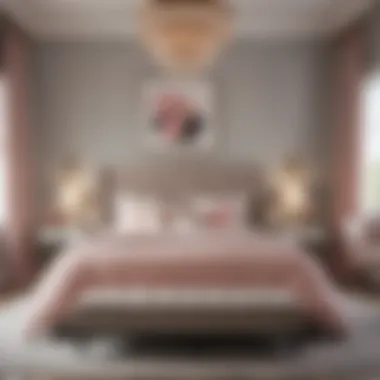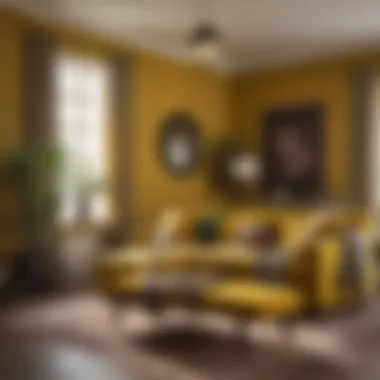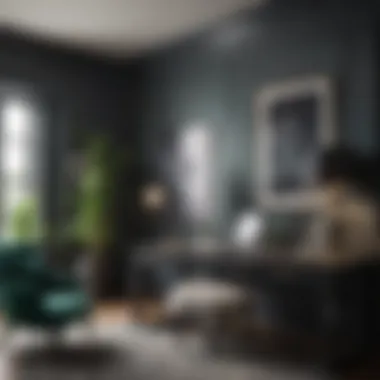Discover the Perfect Room Colors: A Comprehensive Guide


Outdoor Decor Ideas
When it comes to selecting the best colors for each room in your home, outdoor spaces deserve just as much attention. From the exterior of your house to your outdoor living areas, the color choices you make can significantly impact the overall aesthetic appeal.
Seasonal Inspirations
Consider incorporating seasonal inspirations into your outdoor color palette. In spring, opt for soft pastel tones like pale greens, light blues, and blush pinks to reflect the renewal of nature. Summer calls for vibrant hues such as sunshine yellows and fiery oranges to evoke warmth and energy. Fall welcomes earthy shades like warm browns, deep oranges, and rich reds to harmonize with the changing leaves. For winter, create a cozy ambiance with cool blues, silvery grays, and crisp whites reminiscent of snow.
Furniture Selection
The furniture you choose for your outdoor spaces should complement the color scheme. Select outdoor furniture in hues that either harmonize or contrast effectively with the surrounding colors. For example, pair neutral-toned cushions with a colorful outdoor rug for a balanced look, or choose furniture in a bold color as a focal point against a backdrop of more muted tones.
Decorative Lighting
Incorporating decorative lighting into your outdoor decor can enhance the chosen color palette. Select lighting fixtures that either blend in seamlessly with the surroundings or make a statement as contrasting elements. String lights, lanterns, and uplights can all contribute to the overall ambiance while highlighting the colors chosen for your outdoor spaces.
Plant Arrangements


Plants are a natural way to introduce color into your outdoor decor. When selecting plant arrangements, consider the colors of the blooms and foliage. Create visual interest by arranging plants in groups based on complementary or contrasting colors. Additionally, strategically placing colorful pots or planters can further enhance the overall color scheme.
Hardscaping Solutions
Hardscaping elements such as pathways, retaining walls, and patios play a vital role in outdoor decor. Choose materials and finishes that complement the selected color palette. For example, opt for natural stone with warm undertones to harmonize with earthy hues, or select sleek, modern surfaces in contrasting colors to create a unique focal point.
Sustainable Practices
Incorporating sustainable practices into your outdoor decor not only benefits the environment but can also enhance the overall visual appeal. Consider using eco-friendly materials in your outdoor furnishings and decor elements. Integrate water-saving irrigation systems, utilize native plants that require less maintenance, and explore solar-powered lighting options to add functionality while reducing your carbon footprint.
Introduction
Importance of Color in Interior Design
The importance of color in interior design transcends mere visual pleasure; it is the cornerstone upon which the entire ambiance of a room rests. Colors have the remarkable ability to influence emotions, alter perceptions, and even affect the interactions within a space. Understanding the psychological impact of colors is crucial in harnessing their power to create desired effects. Whether aiming for a serene sanctuary or a vibrant social hub, the strategic use of colors can shape the way people experience and interact with a room.
How Color Impacts Mood and Atmosphere


Colors possess an innate language that communicates with our subconscious, shaping our moods and perceptions without us even realizing it. Warm tones like reds and oranges can infuse a space with energy and passion, making it ideal for lively social gatherings. In contrast, cool blues and greens lend a sense of calm and tranquility, perfect for relaxation zones like bedrooms or reading nooks. By understanding how different colors impact emotions and atmosphere, one can curate living spaces that resonate with the desired feelings and purposes envisioned for each room.
Choosing the Right Colors for Different Rooms
In the realm of interior design, the selection of suitable colors for each room plays a pivotal role in creating a harmonious living space. The colors chosen have the power to influence mood, ambiance, and the overall feeling elicited by a room. When contemplating the color scheme for different rooms, factors such as natural lighting, room size, and the intended atmosphere must be deliberated upon meticulously. Each hue carries its unique energy, impacting how inhabitants feel within the space. The right colors can elevate the aesthetics of a room and reflect the desired style, guiding the inhabitants towards specific emotions and functions.
Bedroom
Soft Pastels for a Relaxing Ambiance
Soft pastel shades like pale pinks, light blues, and muted greens are synonymous with tranquility and relaxation in the bedroom. These gentle hues impart a serene aura conducive to unwinding after a hectic day. Soft pastels create a cocoon of coziness, promoting restful sleep and a calm mind. Their delicate tones evoke a sense of peace and foster a soothing environment, ideal for bedrooms meant for relaxation and rejuvenation.
Subdued Blues for Serenity
Subdued blues, with their calming undertones, bring a sense of serenity and composure to the bedroom. Blue is known for its ability to lower blood pressure and heart rate, making it an excellent choice for fostering a tranquil sleeping environment. The subdued nature of this hue provides a sense of balance and emotional stability, ideal for promoting a peaceful and restful atmosphere.
Calming Greens for Nature-inspired Tranquility


Calming greens, reminiscent of nature's lush landscapes, imbue the bedroom with a sense of tranquility and rejuvenation. Green is associated with harmony and balance, creating a restful environment that connects inhabitants with the outside world. The calming attributes of green promote relaxation and well-being, making it a perfect choice for infusing a touch of nature-inspired tranquility into the bedroom.
Tips for Successful Color Combinations
In the realm of interior design, the mastery of color combinations holds immense significance. Crafting a harmonious blend of hues can elevate a space from ordinary to extraordinary. In this context, the strategic utilization of the color wheel serves as a cornerstone for achieving balance and visual appeal. By understanding the fundamentals of complimentary, analogous, and monochromatic color schemes, designers can create a cohesive and visually pleasing environment that resonates with occupants.
Exploring effective color combinations involves a careful consideration of the psychological effects of different hues. Warm tones like reds and yellows can create a welcoming and energetic atmosphere, ideal for communal areas like living rooms. On the other hand, cool tones such as blues and greens exude tranquility, making them perfect for spaces dedicated to relaxation like bedrooms and bathrooms.
The juxtaposition of bold and subdued colors within a room can impart a sense of dynamism and depth. While bold colors inject vibrancy and character into a space, subdued tones provide a tranquil backdrop that prevents visual overload. Striking a delicate balance between these contrasting palettes is essential for creating a harmonious ambiance that appeals to the senses.
Additionally, incorporating accents and textures into the color scheme can add layers of visual interest and tactile allure to a room. Textures like velvet, silk, or reclaimed wood can introduce depth and richness, complementing the chosen color palette. Accents in metallic finishes or natural materials serve as focal points, drawing the eye and creating points of visual interest within the space.
In essence, mastering successful color combinations involves a nuanced understanding of color theory, psychology, and design principles. By employing a thoughtful approach to selecting and pairing colors, designers can transform interiors into dynamic, cohesive, and visually stimulating environments that reflect the personalities and preferences of the occupants.
Conclusion
In the captivating realm of interior design, where the art of color selection holds unparalleled importance, the conclusive segment serves as the pinnacle of wisdom and guidance. As we navigate through the intricacies of color psychology and its profound impact on spatial aesthetics, the significance of the conclusions drawn within this article resonates deeply.
Central to our discourse is the essence of harmonizing colors with emotions, function, and design ethos. For the astute Luxury Travel Curator, High-End Interior Designer, Fine Dining Consultant, Luxury Event Planner, Personal Stylist, and Image Consultant like yourself, unlocking the secrets encapsulated within the culminating segment amplifies your prowess in crafting luxurious and visually captivating spaces.
Delving into the nuanced elements of color schemes, the Conclusion encapsulates the essence of balance, cohesion, and individuality. It underscores the transformative power of colors to evoke sentiments ranging from tranquility to dynamism, thereby shaping the ambiances that define exquisite interiors abundant with character and style.
In this context, the Conclusion emerges not merely as an endnote but as a beacon of knowledge, illuminating the path towards creating immersive spatial experiences that resonate with sophistication and elegance. It underscores the need for deliberate color choices, mindful combinations, and a keen eye for detail - facets indispensable in curating spaces that transcend the ordinary, resonating with refined tastes and discerning sensibilities.







